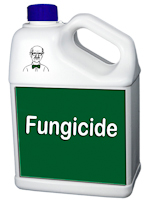 As the name implies,
these are substances that either kill or inhibit the
growth of fungi. The ones used on plants are generally
called protectants. This means that they are
preventative and protect the plant from infection.
Therefore, they must be on the plant BEFORE the fungal
spores land and germinate. Only a few fungicides used
primarily in fruit production have any "back action"
where they have the ability to impact fungi that have
started to grow in the previous few days prior to
application.
As the name implies,
these are substances that either kill or inhibit the
growth of fungi. The ones used on plants are generally
called protectants. This means that they are
preventative and protect the plant from infection.
Therefore, they must be on the plant BEFORE the fungal
spores land and germinate. Only a few fungicides used
primarily in fruit production have any "back action"
where they have the ability to impact fungi that have
started to grow in the previous few days prior to
application.
Most of the fungicides
used on landscape plants are not systemic since they do
not penetrate into the plants. They stay on the surface
and intercept the fungal sports. This means that they
are exposed to ultraviolet light, rain and irrigation
water which will remove them or diminish their
effectiveness over time. That is why timing of
application is very important when using fungicides.
There are a few
fungicides that are systemic. These must be absorbed by
the roots or injected into the trunk of trees. Then,
they move through the water transport system of the tree
to be spread throughout the canopy. Systemic fungicide
treatments tend to be expensive and somewhat invasive
since holes have to be drilled into the bark in order to
deliver the product to the vascular system.
As with most types of
pesticides, some fungicides are narrow spectrum which
control a limited number of fungal species while others
are broad spectrum and kill most any type of fungi they
encounter. Of course, it is usually better to use a
product that is as specific as possible.



